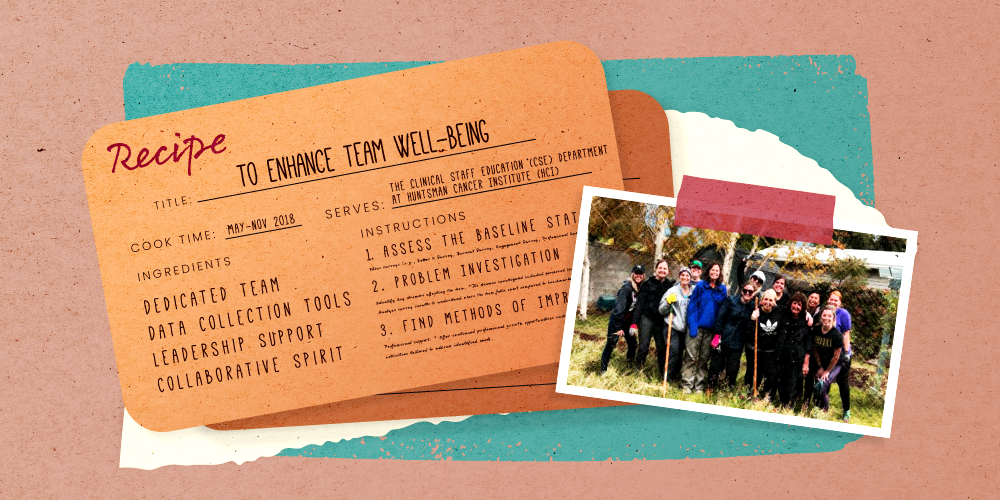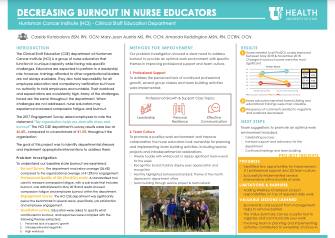Clinical Staff Education (CSE) department at Huntsman Cancer Institute (HCI) is a group of Nursing Professional Development Practitioners (NPDP), also known as nurse educators. They function in a unique capacity while facing role-specific challenges. Educators are expected to perform in leadership roles; however, trainings afforded to other organizational leaders are not always available. They also hold responsibility for all employee education and competency verification but have no authority to hold employees accountable. Their workload and expectations are consistently high. Many of the challenges faced are the same throughout the department.
When challenges are not addressed, nurse educators may experience increased compassion fatigue and burnout.
The goal of the project was to identify departmental stressors and implement appropriate interventions to address them. Our problem investigation showed a clear need to address burnout and to provide an optimal work environment.
Based on these findings, we devised a method for improvement focused on two primary areas: professional support and team culture. To address the perceived lack of continued professional growth, the team implemented group classes and team-building activities. They also took ownership of planning and executing team-building initiatives to foster a positive work environment and improve collaboration.
The success of these interventions prompted the team to consider further steps, including celebrating success, advocating for increased departmental support, and continuing with ongoing trainings and team-building efforts to sustain an optimal work environment.
The following recipe for implementing improvement projects in a team distills the HCI CSE department's successful strategy into actionable steps that can be adapted and applied by other teams facing similar challenges related to burnout, lack of support, and team culture issues.
Recipe for Implementing Improvement Projects in a Team
Ingredients:
- Dedicated Team: Gather a group of individuals who understand the team's challenges and are committed to initiating change.
- Data Collection Tools: Use surveys, assessments, and qualitative methods to gather insights into the team's stressors and burnout levels.
- Leadership Support: Gain buy-in and support from organizational leaders to implement changes effectively.
- Collaborative Spirit: Foster a culture of collaboration, ownership, and mutual support among team members.
Instructions:
1. Assess the Baseline State:
- Utilize surveys (e.g., Better U Survey, Burnout Survey, Engagement Survey, Professional Quality of Life scale) to evaluate burnout levels and specific stressors within the team.
- Collect qualitative data by asking team members about factors contributing to burnout. Extract common themes from their responses.
2. Problem Investigation:
- Identify key stressors affecting the team.
- The stressors investigated included perceived lack of support/growth, intradepartmental negativity, and high workload.
- Analyze survey results to understand where the team falls short compared to benchmarks or organizational averages.
- The HCI CSE department's survey results were low at 36.4%, compared to a benchmark of 41.3% throughout the organization.
3. Methods for Improvement:
Professional Support:
- Offer continued professional growth opportunities such as group classes and team-building activities tailored to address identified needs.
- Several group classes and team-building activities on topics such as leadership, personal resilience, and effective communication were offered.
Team Culture:
- Empower team members to take ownership by planning and executing team-building activities, service projects, and celebrations within the department.
- Healthy team culture established through regular huddles, recognition boards, monthly behavioral standards, and team retreats to foster a positive work environment.
4. Monitor and Evaluate Results:
- Regularly assess progress using surveys, feedback sessions, and qualitative measures.
- Measure changes in burnout scores, engagement levels, and team dynamics.
- Team burnout scores decreased from 35% to 24%.
- Comments related to negativity and workload were noted to decrease in frequency.
5. Analyze Results and Refine Strategies:
- Review the impact of implemented interventions on burnout scores, employee engagement, and team dynamics.
- Identify successful strategies and areas that need further improvement.
6. Results and Next Steps:
- Share positive outcomes, highlighting improvements in burnout scores, reduced negativity, and increased engagement.
- Encourage ongoing suggestions from the team to continue improving the work environment.
- Plan further actions based on team suggestions, focusing on celebrating success, enhancing departmental support, and continuing training and team-building efforts.
Serving Instructions:
- Share the success story of implementing these interventions and encourage other teams to adapt these strategies.
- Emphasize the importance of collaboration, ongoing assessment, and adapting interventions based on team needs.
Notes for Successful Implementation:
- Adapt strategies to fit the specific needs and dynamics of your team.
- Maintain open communication channels to ensure feedback and suggestions are continuously heard and integrated into improvement plans.
- Continuously assess and adapt interventions based on evolving team dynamics and challenges.
This program is supported by the Health Resources and Services Administration (HRSA) of the U.S. Department of Health and Human Services (HHS). The contents are those of the author(s) and do not necessarily represent the official views of, nor an endorsement, by HRSA, HHS, or the U.S. Government. For more information, please visit HRSA.gov.
Cassidy Kotobalavu
Amanda Keddington
Mary-Jean (Gigi) Austria
Despite reported high job satisfaction, burnout can still pose a significant threat to the well-being of teams. Joanne Rolls and Amanda Moloney-Johns share the actionable steps they took to enhance wellness and reduce burnout within their team.
How do I share employee engagement feedback with my team? Chief Wellness Officer Amy Locke, Resiliency Center director Megan Call, Utah Health Academics HR leader Sarah Wilson, and Organizational Development Director Chris Fairbank explain when and how to talk with your team.
The U of U Health Resiliency Center shares a growing list of resources you and your team can use to continue building resilience together.

